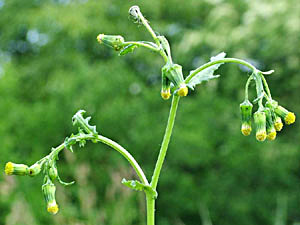
medicinal herbs
Groundsel
Senecio vulgaris

Herb: Groundsel
Latin name: Senecio vulgaris
Family: Compositae
Medicinal use of Groundsel:
Groundsel has a long history of herbal use and, although not an officinal plant, it is still often used by herbalists. The whole herb is anthelmintic, antiscorbutic, diaphoretic, diuretic, emmenagogue and purgative. It is often used as a poultice and is said to be useful in treating sickness of the stomach, whilst a weak infusion is used as a simple and easy purgative. The plant can be harvested in May and dried for later use, or the fresh juice can be extracted and used as required. Use with caution. This plant should not be used by pregnant women, see also the notes above on toxicity. A homeopathic remedy is made from the plant. It is used in the treatment of menstrual disorders and nose bleeds.Description of the plant:

Plant:
Annual
Height:
30 cm(11 3/4 inch)

Flowering:
January toDecember
Habitat of the herb:
Found along roadsides and waste places, it is also a common weed of cultivated land, succeeding on most soils but avoiding shade.Edible parts of Groundsel:
Leaves - cooked or raw. The young leaves have been used in many areas as a salad, though this is very inadvisable, see the notes on toxicity at the top of the page.Propagation of the herb:
Seed - it doesn"t need any encouragement from us.Cultivation of Groundsel:
Found along roadsides and waste places, it is also a common weed of cultivated land, succeeding on most soils but avoiding shade.Known hazards of Senecio vulgaris:
All parts of the plant are poisonous to many mammals, including humans. The toxin affects the liver and has a cumulative affect. Some mammals, such as rabbits, do not seem to be harmed by the plant, and will often seek it out. Various birds also eat the leaves and seeds.Plant information taken from the Plants For A Future.
